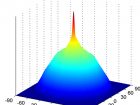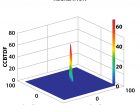
Features
Screens
Structures & Equipment
Research Update: the Many Benefits of Diffuse Light
An Important New Tool for Greenhouse Growers.
March 14, 2017 By Mauricio Manotas
March April 2017 – While the benefits of diffuse light for plants in the greenhouse have long been proven, recent research reveals that the quality of diffuse light is also an important factor in plant quality and productivity.
Most growers tend to simply follow the approach of “diffuse” or “non-diffuse” but new research has proven that there are major differences with respect to the light spectrum. Haze values defining the angles in which light is spread show large variances between diffusion screens and various types of diffuse glass.
When looking at the haze values shown in Figure 1, the top graph illustrates how light is spread around a plane when passing through a light-diffusive screen while the second graphic above shows the same beam of light hitting the surface but in a more vertical way, even though both illustrate what is considered to be light diffusive products.
DIFFUSE COATINGS
Researchers at Wageningen University (WUR) in the Netherlands have found that another widely used option, diffuse coatings, provide variations in light transmission and diffusiveness, depending on the concentration and application. Light levels and diffusivity vary when not applied evenly, so much that in some cases, greenhouses are actually receiving less light than without the diffusive coating (up to seven per cent).
PLANT TEMPERATURE COMPARISONS
Moreover, studies discovered that plant temperature is also impacted. With a diffuse glass or coating, plant temperature tends to be higher when compared to another greenhouse using a diffuse screen with ventilation windows open.
Why? A diffuse screen provides protection when ventilation windows are open. The sun warms up the greenhouse in the morning, meaning less energy is needed, and screens allow for high light transmission even when the sun enters from a low angle.
STUDIES AT A CANADIAN PEPPER OPERATION
Studies at a Canadian pepper greenhouse in Leamington, Ontario, compared two greenhouses with the same temperatures, one with a diffuse coating applied and one with a diffuse screen installed. Researchers found that with a diffusive coating, growers won’t achieve a better climate compared to a diffuse screen. Rather, they will lose the flexibility of having more light on demand.
DESIGNING FOR MORE HOMOGENOUS LIGHT
As growers seek to improve light transmission, they also wish to provide consistent light exposure. Vertical distribution of light penetrating the plant canopy is as important as horizontal light distribution across the greenhouse, minimizing shadows from fixtures and trusses. Scientists in the Netherlands moved two PAR light sensors throughout identical sections in a greenhouse, one section equipped with an original Harmony screen and the other section with New Harmony 2315 O FR, a Svensson screen with 23 per cent shade protection. The sensors continuously measured the light intensity, plotting all points on a graph.
These field tests found that New Harmony allows plants in the shade 32 per cent more light than classic Harmony. Structural shadows are significantly diminished, resulting in all plants receiving more uniform light both per moment and cumulatively. This results in homogeneous growth.
Rose cultivator Peter Lansbergen sees the benefits of his light-diffusive New Harmony screen in his crops. “The shoots receive more light, and my buds are not at risk of being damaged by any direct sunlight. This has improved the quality of the buds. The light in the greenhouse is better distributed over the crop, which results in better outgrowths and better protection of the rose buds.”
Lansbergen’s goal is to maintain over 20 moles in the greenhouse throughout the year. Typically this would mean intensive lighting in the winter months, as there wasn’t enough light outside. “With this screen, it is easier to reach these PAR values with the use of daylight,” he says.
Diffuse Light Benefits
- Better work environment due to lower average temperature.
- Stronger and healthier crops because light reaches deeper into each plant.
- Less risk of burning the plant head because actively scattered sunlight reduces crop temperatures.
- Better growth consistency because all plants get the same amount of light.
- More intense colours, as diffused light intensifies the colour of the flowers.
- Faster growth with a diffused light of better quality.
Currently, more diffuse light studies are underway in greenhouses across Europe and the Americas, at locations including Spain and Netherlands and in the U.S. and Canada, with results to be forthcoming. As research advancements continue forward, we will certainly continue to better explore diffuse light’s benefits and expand our understanding of the connection between light quality and plant productivity.
Mauricio Manotas is president of Ludvig Svensson, Inc., 704-357-0457 or Mauricio.Manotas@Ludvigsvensson.com.
Print this page

